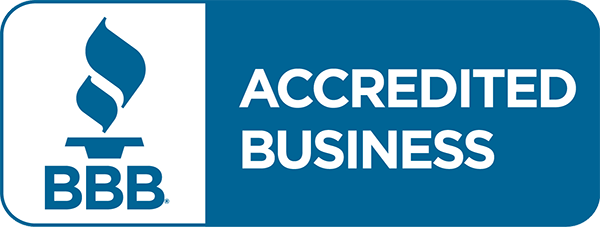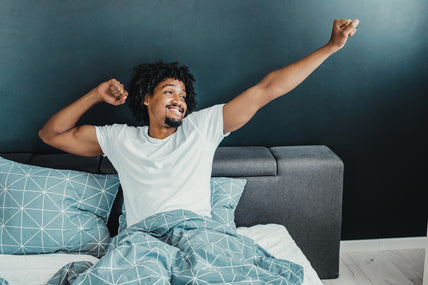5 Techniques to Sleep Better with Anxiety

Quick tip: Take a shower to lower your body temperature just before you hit the bed. Turn off all electronics including; laptops, tablets, and phones to avoid distracting sounds. Keep your bedroom quiet, dark, and cool - and your mind focused on the positives…to set the stage for a good night’s sleep.
Worrying about work, family or your finances can keep your brain active and working overtime when it should be slowing down, so you can fall asleep.
Anxiety [a feeling of worry, nervousness or unease -- especially over something with an uncertain outcome] causes racing thoughts which makes it difficult for the mind to quiet down.
When you’re anxious, the body releases hormones such as; cortisol, adrenalin, and norepinephrine -- that increases heart rate, alertness, and energy levels -- making it difficult to fall asleep or stay asleep at night.
Not getting enough sleep at night can affect your focus and productivity during the day, as well as put you at risk for all kinds of mental and physical illness…and you don’t want that.
So, below are 5 techniques to help you sleep better when dealing with anxiety:
#1: Autogenic training
This technique helps you relax by generating feelings of calm in your body as well as reducing stress and anxiety.
It promotes the natural relaxation response in your body and focuses on slowing breathing, lowering blood pressure and relaxing the mind.
How it works?
Step 1: Find a quiet place free from distractions, lie on the floor or recline in a chair, and spend the first few minutes quietly saying to yourself, “I’m completely calm.”
Step 2: Focus on your arms as you quietly and slowly repeat to yourself 6 times, “My arms are very heavy,” followed by, “I’m completely calm.”
Step 3: Still focused on your arms, quietly and slowly repeat to yourself 6 times, “My arms are very warm,” followed by, “I’m completely calm.”
Step 4: Now, focus attention on your legs as you quietly and slowly repeat to yourself 6 times, “My legs are very heavy,” followed by, “I’m completely calm.”
Step 5: Still focused on your legs, quietly and slowly repeat to yourself 6 times, “My legs are very warm,” followed by, “I’m completely calm.”
Step 6: Quietly and slowly repeat to yourself 6 times, "My heartbeat is calm and regular." Then quietly say to yourself, "I am completely calm."
Step 7: Quietly and slowly repeat to yourself 6 times, "My breathing is calm and regular." Then quietly say to yourself," I am completely calm."
Step 8: Quietly and slowly repeat to yourself 6 times, "My abdomen is warm." Then quietly say to yourself, "I am completely calm."
Step 9: Quietly and slowly repeat to yourself 6 times, "My forehead is pleasantly cool." Then quietly say to yourself, "I am completely calm."
#2: Biofeedback
Biofeedback focuses on awareness, relaxation skills, and tips to manage anxiety. It also shows you how to recognize, reduce, and control stress responses as well as how to maintain the proper brainwave levels needed to achieve calm and focus.
How it works?
The biofeedback technique works via sensors that measure; breathing, heart rate, sweating, body temperature, muscle contraction, and sleep stages:
- Electrical sensors are connected to specific areas of your body, depending on the type of response being measured
- These sensors are then connected to a measurement device that provides feedback on your physical responses
- You’re then guided through different mental exercises that may involve visualization, meditation, breathing, or relaxation techniques
- As you perform these activities, you will receive information on your physical response from the measurement device
DIY wearable devices are also available: One type requires you to wear a sensor on your waist that monitors your breathing and tracks your breathing patterns using a downloadable app. This app alerts you if you're having prolonged tension, and then offers guided breathing activities to help restore your calm.

#3: Breathing
Yes, taking deep, slow, self-aware breathing is an age-long powerful way to relieve the body of tension and stress. It’s a simple, yet effective way to loosen up just before bedtime. Practicing deep breathing sets off a series of physiological changes that go a long way in helping you get a good night’s sleep.
The “4-7-8” breathing technique is especially effective: With your eyes closed, inhale for 4 seconds; hold your breath for 7 seconds; then exhale slowly for 8 seconds. Rinse and repeat until you get into a fully relaxed state.
#4: Guided imagery
Guided imagery [also known as Guided Affective Imagery] is a relaxation technique that uses positive mental images to influence how you feel.
With guided imagery, you use your imagination to create relaxing, positive images and experiences until your body interprets it as real.
How? Okay, assume for a second that you’re sucking on lime [yes, go right ahead…] Imagine the sour sensation as it hits the tip of your tongue. Wait…did your face squeeze from just thinking about this? Well, that’s the power of imagination and yes, guided imagery!
Guided imagery is a powerful technique that can both reduce stress and promote sleep. For instance, imagining being rocked by gentle waves and covered by a warm breeze can help connect the conscious with the unconscious -- directing the body toward desired goals such as relieving physical and mental stress, reducing anxiety, and preparing the body for a good night’s sleep.
Pro Tip: While you can practice guided imagery on your own, it’s best to work with a trained practitioner -- for best results.
#5: Progressive muscle relaxation
Progressive muscle relaxation is a deep relaxation technique based on the simple practice of tensing or tightening one muscle group at a time, followed by a relaxation phase that releases the tension. It’s effective as a nightly power-down routine to control stress and anxiety, as well as relieve insomnia.
How it works?
- Look for a quiet place to lie down
- Gradually slow down your breathing and allow yourself get into a relaxed state
- Tense the muscles in your face, arms, neck, shoulders, chest/stomach, hips/buttocks, and legs
- As you proceed from head to toe, make sure you can feel the tension, but not so much that you feel a great deal of pain
- Keep each muscle tense for approximately 5 seconds
- Then relax the muscles and keep it relaxed for approximately 10 seconds [it might be helpful to say something like ‘relax’ as you relax the muscle]
- Once you’re done, remain seated for a few moment to allow yourself get back into alert mode
So, guys, this is it, but before you go...
You can try our Herbal Calm formula which helps relieve mild to moderate stress during the day and prepares you for a peaceful, restful sleep at night. Ready? Get it, right here.



